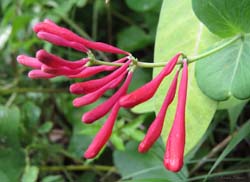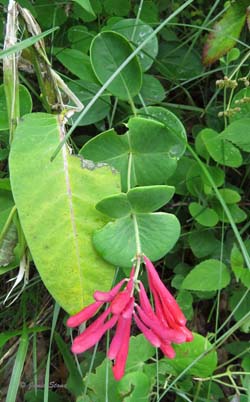Skyline Drive, Shenandoah National Park (Central District), VA

Skyline Drive, Shenandoah National Park (Central District), VA

[ click on any image below to see larger version ]
Family: Caprifoliaceae
Mid-Atlantic bloom time: March - July
Trumpet Honeysuckle's flower inflorescences occur at stem tips and can be red, orange or yellow, attracting hummingbirds for pollination. Just below the clusters of flowers, its leaves are perfoliate, joining at their base to form a complete ring around the stem. Trumpet Honeysuckle is host to larvae of Spring Azure butterflies and Snowberry Clearwing moths. The bright red fruits are eaten by birds such as quail, purple finches, goldfinches, hermit thrushes and robins.
The genus name Lonicera commemorates Adam Lonitzer, a 16th-century German herbalist. The species name sempervirens means 'evergreen', referring to some of the leaves that persist through winter.
Traditional American Indian uses include making a tea out of Trumpet Honeysuckle's leaves as a treatment for asthma, sore throats and coughs. Chewed leaves were applied to bee stings to reduce swelling. The berries will induce nausea or vomiting in humans.
|
21 June 2014
Skyline Drive, Shenandoah National Park (Central District), VA 
|
21 June 2014
Skyline Drive, Shenandoah National Park (Central District), VA 
|